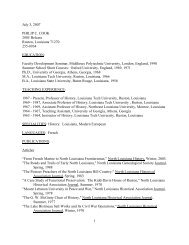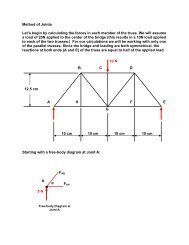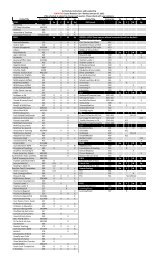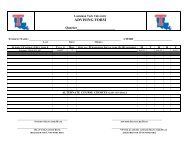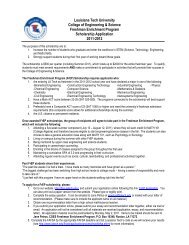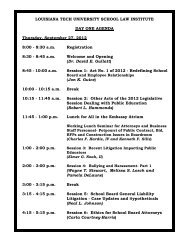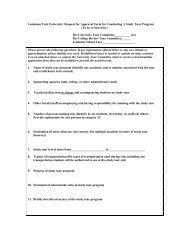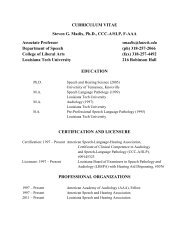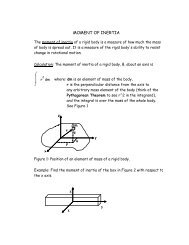Chapter 8: Memory Management
Chapter 8: Memory Management
Chapter 8: Memory Management
You also want an ePaper? Increase the reach of your titles
YUMPU automatically turns print PDFs into web optimized ePapers that Google loves.
The image cannot be displayed. Your computer may not have enough memory to open the image, or the image may have been corrupted. Restart your computer, and then open the file again. If the red x still appears, you may have to delete the image and theninsert it again.<strong>Chapter</strong> 8: <strong>Memory</strong> <strong>Management</strong>!
<strong>Chapter</strong> 8: <strong>Memory</strong> <strong>Management</strong>! Background" Swapping " Contiguous Allocation" Paging" Segmentation" Segmentation with Paging"Operating System Concepts!8.2! Silberschatz, Galvin and Gagne ©2005!
Multistep Processing of a User Program !Operating System Concepts!8.5! Silberschatz, Galvin and Gagne ©2005!
Logical vs. Physical Address Space!The concept of a logical address space that is bound to a separatephysical address space is central to proper memory management" Logical address – generated by the CPU; also referred to asvirtual address" Physical address – address seen by the memory unit"Logical and physical addresses are the same in compile-time andload-time address-binding schemes; logical (virtual) and physicaladdresses differ in execution-time address-binding scheme"Operating System Concepts!8.6! Silberschatz, Galvin and Gagne ©2005!
<strong>Memory</strong>-<strong>Management</strong> Unit (MMU)!Hardware device that maps virtual to physical address"In MMU scheme, the value in the relocation register is added toevery address generated by a user process at the time it is sent tomemory"The user program deals with logical addresses; it never sees thereal physical addresses"Operating System Concepts!8.7! Silberschatz, Galvin and Gagne ©2005!
Dynamic relocation using a relocation register!Operating System Concepts!8.8! Silberschatz, Galvin and Gagne ©2005!
Swapping!A process can be swapped temporarily out of memory to a backingstore, and then brought back into memory for continued execution"Backing store – fast disk large enough to accommodate copies ofall memory images for all users; must provide direct access tothese memory images"Roll out, roll in – swapping variant used for priority-basedscheduling algorithms; lower-priority process is swapped out sohigher-priority process can be loaded and executed"Major part of swap time is transfer time; total transfer time isdirectly proportional to the amount of memory swapped"Modified versions of swapping are found on many systems (i.e.,UNIX, Linux, and Windows)"Operating System Concepts!8.9! Silberschatz, Galvin and Gagne ©2005!
Schematic View of Swapping!Operating System Concepts!8.10! Silberschatz, Galvin and Gagne ©2005!
Demand Paging!Bring a page into memory only when it is needed" Less I/O needed" Less memory needed " Faster response" More users"Page is needed ⇒ reference to it" invalid reference ⇒ abort" not-in-memory ⇒ bring to memory""Operating System Concepts!8.11! Silberschatz, Galvin and Gagne ©2005!
Transfer of a Paged <strong>Memory</strong> to Contiguous Disk Space!Operating System Concepts!8.12! Silberschatz, Galvin and Gagne ©2005!
Valid-Invalid Bit!With each page table entry a valid–invalid bit is associated(1 ⇒ in-memory, 0 ⇒ not-in-memory)"Initially valid–invalid but is set to 0 on all entries"Example of a page table snapshot:Frame #" valid-invalid bit"1"1"1"1"0""0"0"page table""During address translation, if valid–invalid bit in page table entry is 0 ⇒page fault"Operating System Concepts!8.13! Silberschatz, Galvin and Gagne ©2005!
Page Table When Some Pages Are Not in Main <strong>Memory</strong>!Operating System Concepts!8.14! Silberschatz, Galvin and Gagne ©2005!
Steps in Handling a Page Fault!Operating System Concepts!8.15! Silberschatz, Galvin and Gagne ©2005!
What happens if there is no free frame?!Page replacement – find some page in memory, but notreally in use, swap it out" algorithm" performance – want an algorithm which will result inminimum number of page faults"Same page may be brought into memory several times"Operating System Concepts!8.16! Silberschatz, Galvin and Gagne ©2005!
Important Dates!"" Apr 16 Prog Assignment (dinning phil) Apr 18. HW2 due. April 1123, 2013: Midterm exam" April 23 25, 2013: Term Paper " May 9, 2013 : Final exam! " "" ""Operating System Concepts!8.17! Silberschatz, Galvin and Gagne ©2005!
<strong>Memory</strong> Allocations!Operating System Concepts!8.18! Silberschatz, Galvin and Gagne ©2005!
Contiguous Allocation!Main memory usually into two partitions:" Resident operating system, usually held in low memory withinterrupt vector" User processes then held in high memory"Each (Single-partition) allocation" Relocation-register scheme used to protect user processesfrom each other, and from changing operating-system codeand data" Relocation register contains value of smallest physical address;limit register contains range of logical addresses – each logicaladdress must be less than the limit register "Operating System Concepts!8.19! Silberschatz, Galvin and Gagne ©2005!
A base and a limit register define a logical address space!Operating System Concepts!8.20! Silberschatz, Galvin and Gagne ©2005!
HW address protection with base and limit registers!Operating System Concepts!8.21! Silberschatz, Galvin and Gagne ©2005!
Contiguous Allocation (Cont.)!Multiple-partition allocation" Hole – block of available memory; holes of various size arescattered throughout memory" When a process arrives, it is allocated memory from a holelarge enough to accommodate it" Operating system maintains information about:a) allocated partitions b) free partitions (hole)"OS"OS"OS"OS"process 5"process 5"process 5"process 5"process 9"process 9"process 8"process 10"process 2"process 2"process 2"process 2"Operating System Concepts!8.22! Silberschatz, Galvin and Gagne ©2005!
Dynamic Storage-Allocation Problem!How to satisfy a request of size n from a list of free holes"First-fit: Allocate the first hole that is big enough"Best-fit: Allocate the smallest hole that is big enough;must search entire list, unless ordered by size. Producesthe smallest leftover hole."Worst-fit: Allocate the largest hole; must also searchentire list. Produces the largest leftover hole."First-fit and best-fit better than worst-fit in terms ofspeed and storage utilization"Operating System Concepts!8.23! Silberschatz, Galvin and Gagne ©2005!
Example! Given free memory partitions of100K, 500K, 200K, 300K, and 600K(in order), how would each of theFirst-fit, Best-fit, and Worst-fitalgorithms place processes of 212K,417K, 112K, and 426K (in order)? " Which algorithm makes the mostefficient use of memory? "Operating System Concepts!8.24! Silberschatz, Galvin and Gagne ©2005!
Fragmentation!External Fragmentation – Gaps between allocated contiguousmemory - total memory space exists to satisfy a request, but it isnot contiguous"Internal Fragmentation – allocated memory may be slightly largerthan requested memory; this size difference is memory internal to apartition, but not being used"Reduce external fragmentation by compaction! Shuffle memory contents to place all free memory together inone large block" Compaction is possible only if relocation is dynamic, and isdone at execution time" I/O problem" Latch job in memory while it is involved in I/O" Do I/O only into OS buffers"Operating System Concepts!8.25! Silberschatz, Galvin and Gagne ©2005!
Paging!Logical address space of a process can be noncontiguous;process is allocated physical memory whenever the latter isavailable"Divide physical memory into fixed-sized blocks called frames(size is power of 2, between 512 bytes and 8192 bytes)"Divide logical memory into blocks of same size called pages."Keep track of all free frames"To run a program of size n pages, need to find n free frames andload program"Set up a page table to translate logical to physical addresses"Internal fragmentation"Operating System Concepts!8.26! Silberschatz, Galvin and Gagne ©2005!
Address Translation Scheme!Address generated by CPU is divided into:" Page number (p) – used as an index into a page tablewhich contains base address of each page in physicalmemory" Page offset (d) – combined with base address to definethe physical memory address that is sent to the memoryunit"Operating System Concepts!8.27! Silberschatz, Galvin and Gagne ©2005!
Address Translation Architecture!Operating System Concepts!8.28! Silberschatz, Galvin and Gagne ©2005!
Paging Example !Operating System Concepts!8.29! Silberschatz, Galvin and Gagne ©2005!
Paging Example!Operating System Concepts!8.30! Silberschatz, Galvin and Gagne ©2005!
Free Frames!Before allocation"After allocation"Operating System Concepts!8.31! Silberschatz, Galvin and Gagne ©2005!
Implementation of Page Table!Page table is kept in main memory"Page-table base register (PTBR) points to the page table"Page-table length register (PRLR) indicates size of the pagetable"In this scheme every data/instruction access requires twomemory accesses. One for the page table and one for thedata/instruction."The two memory access problem can be solved by the useof a special fast-lookup hardware cache called associativememory or translation look-aside buffers (TLBs)!Operating System Concepts!8.32! Silberschatz, Galvin and Gagne ©2005!
Associative <strong>Memory</strong>! Associative memory – parallel search "Page #" Frame #""Address translation (A´, A´´)" If A´ is in associative register, get frame # out" Otherwise get frame # from page table in memory"Operating System Concepts!8.33! Silberschatz, Galvin and Gagne ©2005!
Paging Hardware With TLB!Associate <strong>Memory</strong>"Operating System Concepts!8.34! Silberschatz, Galvin and Gagne ©2005!
Effective Access Time!Associative Lookup = ε time unit"Assume memory cycle time is 1 microsecond"Hit ratio – percentage of times that a page number is foundin the associative registers; ration related to number ofassociative registers" Hit ratio = α""Effective Access Time (EAT)"" "EAT = (1 + ε) α + (2 + ε)(1 – α)"" " "= 2 + ε – α"Operating System Concepts!8.35! Silberschatz, Galvin and Gagne ©2005!
<strong>Memory</strong> Protection!<strong>Memory</strong> protection implemented by associating protection bitwith each frame"Valid-invalid bit attached to each entry in the page table:" “valid” indicates that the associated page is in theprocess’ logical address space, and is thus a legal page" “invalid” indicates that the page is not in the process’logical address space"Operating System Concepts!8.36! Silberschatz, Galvin and Gagne ©2005!
Valid (v) or Invalid (i) Bit In A Page Table!Operating System Concepts!8.37! Silberschatz, Galvin and Gagne ©2005!
Swapping!Operating System Concepts!8.38! Silberschatz, Galvin and Gagne ©2005!
Virtual <strong>Memory</strong>! Elusion to expand memory view ontothe secondary storage." Moving pages – frames betweenmemory and HD" Demand paging"Operating System Concepts!8.39! Silberschatz, Galvin and Gagne ©2005!
Demand Paging!Bring a page into memory only when it is needed" Less I/O needed" Less memory needed " Faster response" More users"Page is needed ⇒ reference to it" invalid reference ⇒ abort" not-in-memory ⇒ bring to memory""Operating System Concepts!8.40! Silberschatz, Galvin and Gagne ©2005!
Transfer of a Paged <strong>Memory</strong> to Contiguous Disk Space!Operating System Concepts!8.41! Silberschatz, Galvin and Gagne ©2005!
Valid-Invalid Bit!With each page table entry a valid–invalid bit is associated(1 ⇒ in-memory, 0 ⇒ not-in-memory)"Initially valid–invalid but is set to 0 on all entries"Example of a page table snapshot:Frame #" valid-invalid bit"1"1"1"1"0""0"0"page table""During address translation, if valid–invalid bit in page table entry is 0 ⇒page fault"Operating System Concepts!8.42! Silberschatz, Galvin and Gagne ©2005!
Page Table When Some Pages Are Not in Main <strong>Memory</strong>!Operating System Concepts!8.43! Silberschatz, Galvin and Gagne ©2005!
Steps in Handling a Page Fault!Operating System Concepts!8.44! Silberschatz, Galvin and Gagne ©2005!
What happens if there is no free frame?!Page replacement – find some page in memory, but notreally in use, swap it out" algorithm" performance – want an algorithm which will result inminimum number of page faults"Same page may be brought into memory several times"Operating System Concepts!8.45! Silberschatz, Galvin and Gagne ©2005!
Page Table Structure!Hierarchical Paging"Hashed Page Tables"Inverted Page Tables"Operating System Concepts!8.46! Silberschatz, Galvin and Gagne ©2005!
Hierarchical Page Tables!Break up the logical address space into multiple page tables"A simple technique is a two-level page table"Operating System Concepts!8.47! Silberschatz, Galvin and Gagne ©2005!
Two-Level Paging Example!A logical address (on 32-bit machine with 4K page size) is divided into:"a page number consisting of 20 bits"a page offset consisting of 12 bits"Since the page table is paged, the page number is further divided into:" a 10-bit page number "a 10-bit page offset"Thus, a logical address is as follows:page number"p i " p 2 " d"page offset"10" 10" 12"where p i is an index into the outer page table, and p 2 is the displacementwithin the page of the outer page table"Operating System Concepts!8.48! Silberschatz, Galvin and Gagne ©2005!
Two-Level Page-Table Scheme!Operating System Concepts!8.49! Silberschatz, Galvin and Gagne ©2005!
Address-Translation Scheme!Address-translation scheme for a two-level 32-bit pagingarchitecture"Operating System Concepts!8.50! Silberschatz, Galvin and Gagne ©2005!
Stop Here 4/23!Operating System Concepts!8.51! Silberschatz, Galvin and Gagne ©2005!
Hashed Page Tables!Common in address spaces > 32 bits"The virtual page number is hashed into a page table. This pagetable contains a chain of elements hashing to the same location."Virtual page numbers are compared in this chain searching for amatch. If a match is found, the corresponding physical frame isextracted."Operating System Concepts!8.52! Silberschatz, Galvin and Gagne ©2005!
Hashed Page Table!Operating System Concepts!8.53! Silberschatz, Galvin and Gagne ©2005!
Inverted Page Table!One entry for each real page of memory"Entry consists of the virtual address of the page stored inthat real memory location, with information about theprocess that owns that page"Decreases memory needed to store each page table, butincreases time needed to search the table when a pagereference occurs"Use hash table to limit the search to one — or at most afew — page-table entries"Operating System Concepts!8.54! Silberschatz, Galvin and Gagne ©2005!
Inverted Page Table Architecture!Operating System Concepts!8.55! Silberschatz, Galvin and Gagne ©2005!
Shared Pages!Shared code! One copy of read-only (reentrant) code shared amongprocesses (i.e., text editors, compilers, window systems)." Shared code must appear in same location in the logicaladdress space of all processes" Private code and data " Each process keeps a separate copy of the code and data" The pages for the private code and data can appearanywhere in the logical address space"Operating System Concepts!8.56! Silberschatz, Galvin and Gagne ©2005!
Shared Pages Example!Operating System Concepts!8.57! Silberschatz, Galvin and Gagne ©2005!
Segmentation! <strong>Memory</strong>-management scheme that supports user view of memory "A program is a collection of segments. A segment is a logical unitsuch as:"" "main program,"" "procedure, "" "function,"" "method,"" "object,"" "local variables, global variables,"" "common block,"" "stack,"" "symbol table, arrays"Operating System Concepts!8.58! Silberschatz, Galvin and Gagne ©2005!
User’s View of a Program!Operating System Concepts!8.59! Silberschatz, Galvin and Gagne ©2005!
Logical View of Segmentation!1"1"4"2"3"4"2"3"user space "physical memory space"Operating System Concepts!8.60! Silberschatz, Galvin and Gagne ©2005!
Stop here!Operating System Concepts!8.61! Silberschatz, Galvin and Gagne ©2005!
Segmentation Architecture !Logical address consists of a two tuple:"" ","Segment table – maps two-dimensional physical addresses;each table entry has:" base – contains the starting physical address where thesegments reside in memory" limit – specifies the length of the segment"Segment-table base register (STBR) points to the segmenttable’s location in memory"Segment-table length register (STLR) indicates number ofsegments used by a program;"" segment number s is legal if s < STLR"Operating System Concepts!8.62! Silberschatz, Galvin and Gagne ©2005!
Segmentation Architecture (Cont.)!Relocation." dynamic" by segment table "Sharing." shared segments" same segment number "Allocation." first fit/best fit" external fragmentation"Operating System Concepts!8.63! Silberschatz, Galvin and Gagne ©2005!
Segmentation Architecture (Cont.)!Protection. With each entry in segment table associate:" validation bit = 0 ⇒ illegal segment" read/write/execute privileges"Protection bits associated with segments; code sharingoccurs at segment level"Since segments vary in length, memory allocation is adynamic storage-allocation problem"A segmentation example is shown in the following diagram"Operating System Concepts!8.64! Silberschatz, Galvin and Gagne ©2005!
Address Translation Architecture !Operating System Concepts!8.65! Silberschatz, Galvin and Gagne ©2005!
Example of Segmentation!Operating System Concepts!8.66! Silberschatz, Galvin and Gagne ©2005!
Sharing of Segments!Operating System Concepts!8.67! Silberschatz, Galvin and Gagne ©2005!
Segmentation with Paging – MULTICS!The MULTICS system solved problems of externalfragmentation and lengthy search times by paging thesegments"Solution differs from pure segmentation in that thesegment-table entry contains not the base address ofthe segment, but rather the base address of a pagetable for this segment"Operating System Concepts!8.68! Silberschatz, Galvin and Gagne ©2005!
MULTICS Address Translation Scheme!Operating System Concepts!8.69! Silberschatz, Galvin and Gagne ©2005!
Intel 30386 Address Translation!Operating System Concepts!8.71! Silberschatz, Galvin and Gagne ©2005!
Linux on Intel 80x86!Uses minimal segmentation to keep memory managementimplementation more portable"Uses 6 segments:" Kernel code" Kernel data" User code (shared by all user processes, using logicaladdresses)" User data (likewise shared)" Task-state (per-process hardware context)" LDT"Uses 2 protection levels:" Kernel mode" User mode"Operating System Concepts!8.72! Silberschatz, Galvin and Gagne ©2005!
The image cannot be displayed. Your computer may not have enough memory to open the image, or the image may have been corrupted. Restart your computer, and then open the file again. If the red x still appears, you may have to delete the image and theninsert it again.End of <strong>Chapter</strong> 8!



